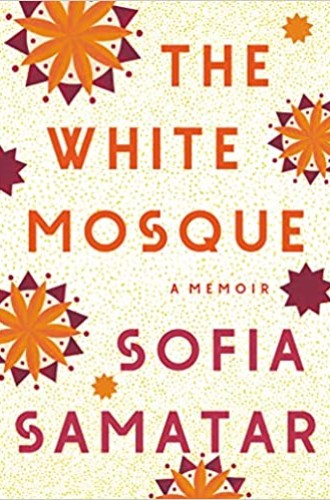The journey to a lost Mennonite colony in Uzbekistan
Sofia Samatar’s memoir takes readers through a landscape of prismatic identities and wandering passions.
“How can you be half a religion?” The question comes to Sofia Samatar in a way that characterizes her memoir of a pilgrimage across Uzbekistan in search of a lost colony of Mennonites: through several lenses at once and in the form of an incomplete story.
At dinner one evening in Bukhara, Samatar’s friend Diane says that she once told someone she was “half Mennonite.” That person’s response was, “How can you be half a religion?” Their Uzbek guide immediately picks up on the question and tells them that Uzbekistan is full of “half Muslims.” He quotes the 11th-century scholar and poet Omar Khayyam, who says, “Their right hand is on the Qur’an, their left hand on the bottle.” One of the Uzbeks at the table thinks this is funny. Another “looks severe.” Then Samatar adds, “For dessert, a Rice Krispie treat stuffed with dried fruit,” as if that image will clarify the different definitions of religion, identity, and culture that are at play.
This is the landscape The White Mosque takes you through: one of prismatic identities and wandering passions, with the hope and the question of fidelity and coherency at the center.
Samatar is the daughter of a Somali schoolteacher who fell in love with a Mennonite missionary. The two of them moved together to the United States—to Mennonite country, where Samatar was raised as a Mennonite. A poet and author of science fiction and fantasy novels and short stories, Samatar uses her skills of thinking outside ordinary frames to tell multiple stories at once in this memoir.
One is the tragic story of a group of Mennonites who left Russia in the 19th century at the behest of an apocalyptic preacher named Claas Epp Jr., who believed that they needed to find the place in Central Asia where Christ would soon return. This led them to a place that local people called Ak Metchet (the white mosque), a compound in southeast Uzbekistan where the community lived until the Soviet period. The second is the story of a contemporary group of North American Mennonites who join a tour to follow in the footsteps of this group and see what of their legacy remains. The third is the story of Samatar’s own identity and the conflicting trajectories of race and religion that define and disrupt it.
The task of tracking these stories and their various characters is not an easy one. The layers are dense, and sometimes I longed for Samatar to make things clearer for me. But once I became at least familiar with the stories’ contours—the Russian Mennonites have a rough time, and things fall apart; the North American group is devoted and curious, but Samatar’s quest stands apart from theirs—I could begin to partake of the delights Samatar has prepared.
There are the delights of deep meditation on identity and the legacy of Christian missionaries. Samatar reflects on her time in Egypt and South Sudan working with Mennonite Central Committee:
How do we enter the stories of others? . . . For a long time it has seemed to me that, within the dominant strain of North American Mennonite culture, such an entrance takes a form I call the missionary effect. We long—intend—demand—to be of service. We must arrive with something to offer, if not the Bible, then a language, a medical treatment, a seed.
The problem is that inherent in this desire to offer something is an inescapable cultural superiority, even if you are not there to proselytize. If you don’t go to “give God,” you go to give “development, the grand universal of our time, the great world religion” and to receive “experience in return.” This dynamic leads Samatar to a hilarious chapter in which she tries to gather all the contradictory messages she’s received about Mennonite missionaries onto one absurdist page.
Samatar observes that the stories that shape our identities remain impervious to historical accuracy. For example, the majority of the world’s Mennonites are people of color, and the most representative Mennonite would be an African woman. Yet the core story of being a Mennonite is so rooted in European identity, practice, and skin color that it has remained unshaken by geography, demography, and history itself. Speaking of the Mennonites who followed Epp but also of how Mennonite identity is constructed now, she wonders, “What is any group identity but a story that a whole community has swallowed?”
Samatar can’t say, in the end, that she is sorry that her mother was so caught up in missionary zeal that she traveled across the world to find and convert her father. She can’t say that she is sorry that her father came back to America and became a professor, even as she observes his below-the-surface rage when people suggest that he was somehow “saved” from Somalia. But she also cannot survive without questioning to an existential degree these choices of her parents. “Like the children born at Ak Metchet,” she writes, “I have a dream of the end at my beginning. My origins are apocalyptic.”
It is delightful to follow Samatar on rabbit trails through remnants of the Ak Metchet Mennonites. We wander through the story of the American actress Irene Worth, daughter of one of the murdered Mennonites, who buried her identity deep. We look at Martyrs Mirror, a 17th-century text that Samatar says is, after the Bible, “the most influential book in the history of Mennonites.” It’s a compendium of martyr stories, a “catalogue of pain,” “a glut of blood” that Samatar relates to the quietist impulses of contemporary Mennonites, “trauma as a form of time travel.”
But we also go with Samatar as her pilgrimage morphs into a love story focused on an early 20th-century Uzbek photographer, Khudaybergen Divanov, who was trained by one of the Ak Metchet Mennonites. “To document is to take on a project of cherishing,” Samatar writes about both Divanov and herself. “You decide, over and over, to honor a particular word, record, or memory.” At the same time, she questions that cherishing: “Are you allowed to love a stranger? If so, what form should that love take? Is it permissible to identify with another? What if you are very ignorant, you don’t speak the other’s language, if you’re simply allowing the light to get into your eyes?”
By the end of the pilgrimage, she and her companions are wandering around Ak Metchet looking at desks and chalkboards and old tin, delighting in and exclaiming about these remnants. Samatar, having taken us on an apocalyptic journey, notes the inherent strangeness: “The Mennonite trek, a journey in anticipation of the world’s end, has produced this pilgrimage to mundane things, this group of people enthralled by flaking paint and dented tin. We are historians, documentarists: we love this world.”
History, identity, and religion all end up being fragmented things. And we love them, even though they aren’t whole and won’t ever be whole, no matter how far we traveled to look for them.






